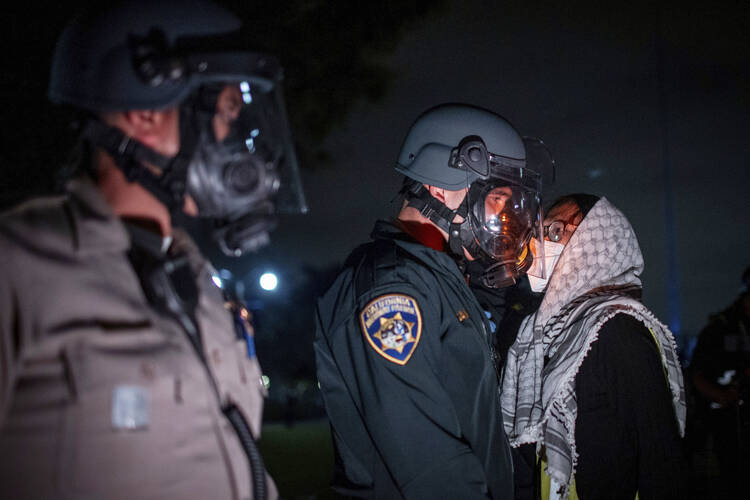On May 1, I watched from the roof of our Jesuit community residence as a crowd faced off with police outside the Fordham Lincoln Center campus across the street. Earlier that morning, protesters had set up an encampment inside a lobby at an entrance to the campus.
Around 6 p.m. that evening, the police arrested 11 Fordham students and four alumni who had refused to leave the encampment, while officers outside interposed themselves between the wall of windows looking into the lobby and the crowd on the sidewalk.
From the crowd outside, there were chants of “Free, free Palestine,” calls for a cease-fire and demands for the university to divest from companies linked to Israel. There were Muslim students kneeling on prayer rugs; there were signs about justice and Jesuit values. But the crowd also chanted “N.Y.P.D., K.K.K.” and “There is only one solution: intifada revolution.”
After the protesters in the encampment had been arrested, the crowd dispersed without further confrontation with the police.
On the other side of the country, events unfolded differently at a pro-Palestinian protest encampment at the University of California, Los Angeles. According to an analysis of videos by The New York Times, on the night of April 30, counterprotesters began tearing down the barricades, shooting fireworks toward the encampment and attacking people within it. They continued for hours before the police arrived and for some time even after the police were on the scene. On May 1, protesters were threatened with arrest if they did not leave, and the police cleared the encampment in the early hours of May 2.
Why is it so easy for righteous anger at violence to result in endorsement and escalation of violence, both verbal and physical? How does speaking up against the war in Gaza lead to slandering New York police officers, many of whom are themselves not white, as “K.K.K.”? How does it justify chanting “intifada,” which, no matter what broader meaning may be intended, signals approval of a history of suicide bombings targeting Israeli civilians? How does bearing witness to those murdered on Oct. 7 or calling attention to the hostages still being held by Hamas become license to charge toward and attack protesters, destroying any possibility of their demonstration concluding peacefully?
The danger of an opponent whom you can thoroughly hate is as basic as the problem of the ends justifying the means. If a cause is so evil that it must be opposed at all costs, it becomes all too easy to ignore anyone who suffers those costs.
The seductive temptation of completely detesting an enemy is that no matter how much power we might actually hold, we get to play David to another’s Goliath. We do not have to ask how we can make peace, because any means that can destroy an evil so immense and dangerous is automatically justified.
So Israel, which faces real danger from Hamas’s continued commitment to terrorist violence, can continue to postpone grappling with the fact that it holds life and death power over three million Palestinians in the occupied West Bank and more than two million in Gaza under siege. As long as the threat persists, 34,000 deaths and the specter of famine in Gaza seem a lesser responsibility to Israel than the safety of its own citizens.
So protesters at universities in the United States, outraged by the near-total destruction of Gaza and the impotence of international pressure to restrain Israel’s use of force or even significantly improve the delivery of humanitarian aid, can adopt slogans echoing those with which Hamas justifies murder. As long as Palestinians are living under Israeli occupation, any act of violence, no matter whom it targets, can be described as resistance against oppression.
While these temptations to detest an enemy may run parallel to each other, they are not therefore symmetrical. Israel’s military superiority—sustained by U.S. funds and weapons—makes the violence they are unleashing on Gaza far more deadly than Hamas’s. And while a unilateral surrender and return of hostages by Hamas could stop the war, it is Israel that continues to bomb cities filled with civilian refugees.
Any significant move toward peace requires one side to offer to forswear violence that it could justify by its own moral logic. There is no “safe” way, under those logics, for either to make that move first.
Many pro-Israel activists display pictures of hostages still being held by Hamas. A photo from the Fordham student newspaper’s reporting on the encampment shows a tent with a sign that reads, “All eyes on Gaza.” But the temptation to detest an enemy as completely evil takes focus away from those who are suffering, directing it obsessively toward the danger of what must be opposed.
Finding hope requires imagining more than an enemy’s defeat. It requires imagining that they, too, are capable of seeking a good that can be shared.








